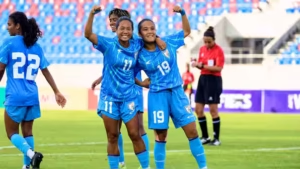The Indian Women’s League, IWL 2025–26 will unfold in an unprecedented two-phase format, marking one of the most significant structural shifts in Indian women’s football since the league’s inception.
The All India Football Federation (AIFF) confirmed the revised schedule following discussions with all eight participating clubs, with defending champions East Bengal headlining a campaign now shaped primarily around national team priorities. This season’s calendar runs from December 20, 2025 to May 10, 2026, but only 39 of those days will feature competitive league matches. The remaining 103 days form a scheduled mid-season break designed to accommodate the Indian women’s national team’s extended preparation camp for the AFC Women’s Asian Cup 2026.
While the AIFF emphasises that the two-phase structure was supported by club representatives, this new model introduces complex implications for competition rhythm, club finances, player conditioning, and the long-term professionalisation of the women’s game in India. The IWL will begin with Phase 1 from December 20, 2025 to January 6, 2026. This opening stage is compact, lasting just 18 days, during which clubs are expected to play the first half of the league schedule. Following this, the league will enter a 103-day hiatus one of the longest mid-season breaks in any professional league globally. Phase 2 resumes on April 20, 2026 and concludes on May 10, 2026, during which the remaining matches will decide the league standings and title.

The primary purpose of this break is to create an uninterrupted training window for the national team ahead of the AFC Women’s Asian Cup. The Blue Tigresses have already qualified for the tournament, expected to take place in March 2026, and the federation has planned an 83-day preparation programme that includes 10–12 international friendlies and 5–7 domestic competitive fixtures. The goal, according to the AIFF, is to ensure national team players accumulate approximately 30 competitive match exposures in the months leading into the Asian Cup.
In framing the decision, the AIFF emphasised that the national team’s performance on the continental stage must take precedence, and that the league calendar should facilitate rather than obstruct international preparation.
Centralised Venues and the Sacrifice of Home Identity
Both phases of the IWL will be conducted at centralised venues. This contrasts sharply with the natural home-and-away model that club football traditionally relies upon to build community identity, fan loyalty, and match-day revenue streams. Clubs such as East Bengal, Gokulam Kerala, and Garhwal United possess established home stadiums where they have cultivated local support bases; those advantages will not be utilised in the upcoming season.
This centralised format aligns with logistical efficiency but comes at the cost of commercial and developmental value. Without home matches, clubs lose local engagement opportunities and match-day earnings critical revenue for a league still developing its sponsorship and broadcast ecosystem.
Perhaps the most pressing footballing concern is the impact of the 103-day break on player fitness and match sharpness. National team players will remain in high-intensity training throughout the break. However, the majority of players particularly those not selected for the national camp will experience an extended period without competitive fixtures. For professional athletes, three months without match minutes poses a significant risk of rhythm loss and higher injury likelihood upon return.
When Phase 2 begins, clubs will effectively re-enter the season after what amounts to a second pre-season. Tactical structures, pressing intensity, and playing chemistry built only briefly during Phase 1 must be rediscovered under compressed timelines at the decisive stage of the season. This creates distinct conditions in which some players return battle-hardened from national duties, while others resume competitive play from a state of under-stimulation, potentially widening performance gaps within squads.
IWL clubs now face the challenge of maintaining full squad payroll and support staff through a long non-competitive period without corresponding revenue activity. Professional football contracts do not pause during competition breaks, meaning clubs shoulder the cost of player retention while deriving no match-day returns for over three months. Foreign players, in particular, present financial risk. Clubs must retain and train them through the hiatus to ensure availability for Phase 2, even though their match involvement will be minimal during the break. Without additional financial support, smaller clubs may struggle to justify such retention.
The situation also threatens sponsorship continuity. Brand partnerships depend on consistent exposure. A league that disappears from public view for an entire quarter risks reduced value perception among commercial partners and broadcasters. The 2024–25 season’s limited TV presence already highlighted the fragility of the IWL’s media profile; a prolonged mid-season quiet period will make sustaining visibility even more difficult.
A Necessary Short-Term Tradeoff, but Not a Long-Term Model
The two-phase structure reflects a strategic tradeoff: sacrificing domestic league continuity to maximise the national team’s competitiveness on the continental stage. The Asian Cup is arguably the highest priority event in Indian women’s football, and the AIFF has chosen to concentrate resources and structural flexibility to support the team’s preparation.
However, the long-term professionalisation of women’s club football requires a league structure that is continuous, commercially viable, and capable of providing stable employment and development pathways. A system that can be paused for three months at any time cannot yet be considered a mature professional league. To prevent lasting structural damage, the AIFF will need to introduce compensation frameworks for clubs, development plans for non-national players during the break, and a clear assurance that this split-season model will not become permanent.
The 2025–26 season may ultimately be judged not by who wins the IWL title, but by whether Indian football succeeds in balancing national ambition with the foundational stability required to grow the women’s game at all levels.
How useful was this post?
Click on a star to rate it!
Average rating 0 / 5. Vote count: 0
No votes so far! Be the first to rate this post.






